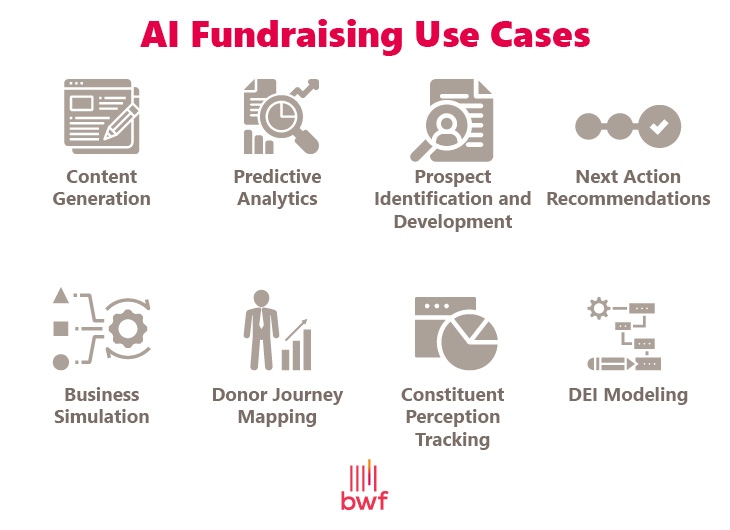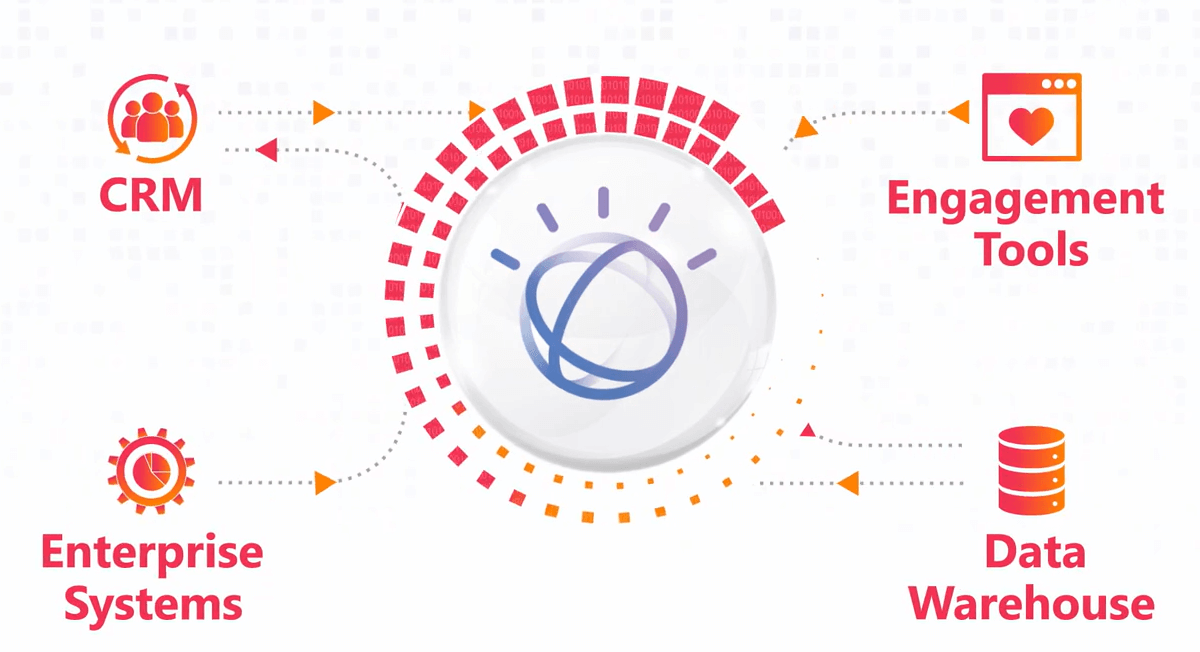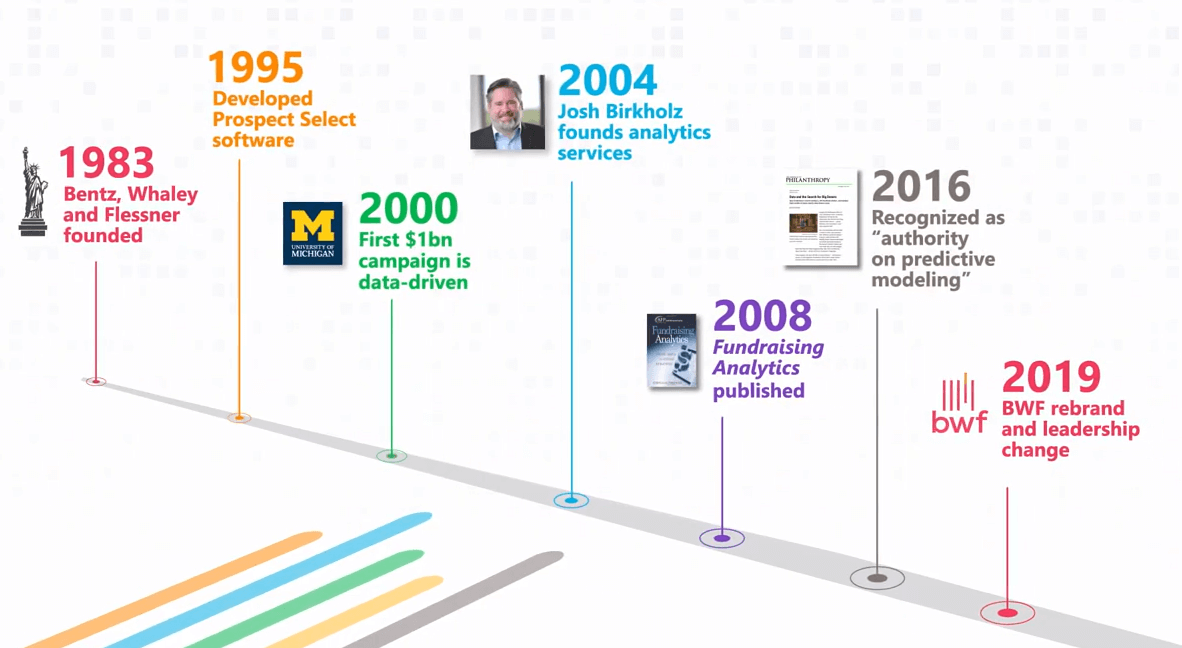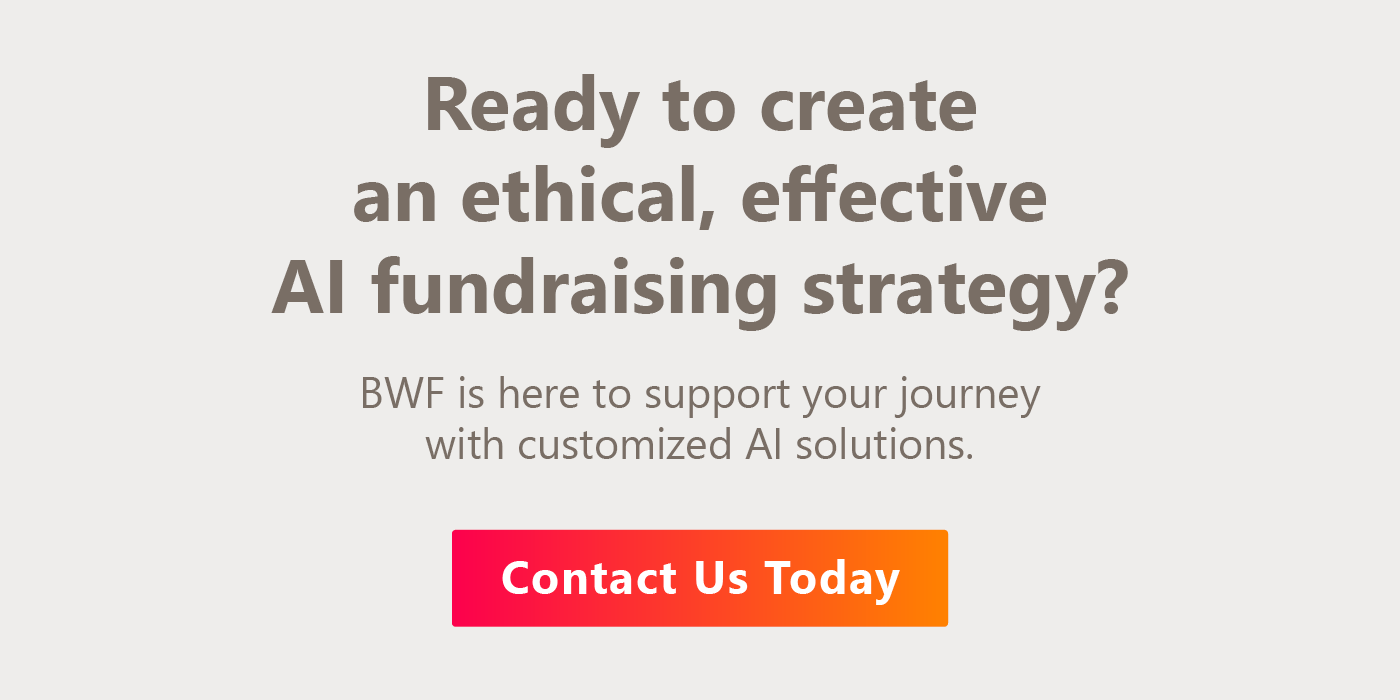The advancements made possible by artificial intelligence (AI) are transforming the fundraising landscape. AI tools take the guesswork out of the fundraising process, allowing organizations to focus more of their energy on their top prospects. Now, over half of nonprofits are using AI in some capacity to support their charitable goals.
You may have recently started hearing more about AI fundraising and want to learn how to jump in. In this guide, we’ll review what your organization needs to know about how AI can support your strategies and where to get started. We’ll cover:
- What is AI Fundraising?
- AI Fundraising Use Cases
- Benefits of AI Fundraising and Donor AI Solutions
- Ethical Considerations of AI Fundraising Technology
- Finding the Right AI Fundraising Approach
AI fundraising can support multiple aspects of your nonprofit’s strategy, from digital fundraising to prospect cultivation. Let’s dive in by reviewing some of the most effective uses of AI fundraising.
What is AI Fundraising?
Before defining AI fundraising, let’s start by establishing what AI is. Computer scientist John McCarthy, considered a “founding father” of AI, defines artificial intelligence as “the science and engineering of making intelligent machines, especially intelligent computer programs. It is related to the similar task of using computers to understand human intelligence, but AI does not have to confine itself to methods that are biologically observable.”
Essentially, AI tools use machine learning to mimic human intelligence, completing tasks and functions that would otherwise require human intervention.
Therefore, AI fundraising is the use of AI technology and algorithms to support nonprofit fundraising efforts. Some AI fundraising tools use nonprofit data, such as donor or constituent data, to predict future behaviors. Other solutions help organizations automate manual processes or determine the right next steps to take to secure a donation.
In the next section, we’ll explore the multitude of use cases for AI fundraising tools.
AI Fundraising Use Cases
According to a report from Stanford’s Institute for Human-Centered Artificial Intelligence (HAI), around 80% of nonprofits that use AI leverage it for supportive work (finance, human resources, technology, communications, etc.), while only about 60% deploy AI for mission-related work (working with clients, implementing programs, or making grants).
AI fundraising tools run the gamut, from chatbots to tools that can detect fraud and automate communications. If your nonprofit is interested in using these solutions for more than just supportive work, there are plenty of opportunities to branch out to access innovative resources that support your mission and goals.
Here are a few ways that these tools can support your fundraising efforts:

Content generation
Generative AI solutions like ChatGPT produce images, text, videos, and audio in response to instructional input. Generative AI tools are especially useful in the content generation or brainstorming process. Fundraisers can use these solutions to:
- Develop blog post ideas.
- Generate eye-catching email subject lines.
- Research unfamiliar topic areas.
- Draft social media posts and email content.
- Write grant applications.
- Identify useful questions for donor satisfaction surveys
- Create fundraising scripts for phone calls or in-person donation requests.
- Brainstorm ideas for fundraising campaign themes, slogans, or taglines.
Keep in mind that AI-generated content can have factual errors and lack authenticity, which can decrease the quality of your content and even negatively affect your SEO strategy. That’s why it’s important to edit any AI-generated content to reflect your nonprofit’s unique brand and voice, as well as fact-check this content for accuracy. These practices will help maintain audience engagement and trust.
Predictive analytics
Nonprofits can train AI tools to develop predictive models using their unique datasets. Predictive analytics anticipate future donor behavior by assessing a nonprofit’s existing dataset for patterns and trends.
Predictive models can take several different forms, such as:
- Models for giving behaviors, such as preferred giving channel, likelihood of renewal, and likely next gift amount.
- Predictive scoring, including engagement scoring and RFM (recency, frequency, and monetary) value.
- Models for giving program success, such as annual giving, major giving, planned giving, etc.
One of the most useful applications of predictive modeling is identifying prospects — we’ll explore this use case in more detail in the next section.
Prospect identification and development
AI can streamline wealth screening results verification, prospect profile development, portfolio optimization, and more.
For example, at BWF, we build AI predictive models to help organizations identify prospects who are most likely to:
- Start giving when they haven’t before (This strategy is often used in higher education fundraising to reach alumni or in healthcare fundraising to connect with patients.)
- Reactivate, or start giving again when they haven’t for a while
- Renew, or give again this year after they gave last year
- Upgrade, or give more than they have been giving
- Become major or principal donors by giving at a significant level
- Become legacy donors by making a gift as part of their estate plan
Once you’ve identified your top prospects, you can direct more of your fundraising team’s time and attention to stewarding these potential donors.
Join our upcoming webinar to learn how to take the guesswork out of AI!
Next action recommendations
With the information gathered throughout the prospect research process, the BWF team helps fundraisers take this analysis a step further by leveraging AI models to determine the right:
- Ask amounts. We build models that predict the amount a prospect is most likely to donate, letting you know how much you should request from them.
- Channel mix. Our models also help predict which prospects will respond best to different outreach methods, such as emails, paper mailings, phone calls, events, etc.
- Messaging. We can also help determine what type of messaging a prospect is most interested in, like historical/legacy stories, innovative initiatives at your organization, your leadership’s vision and direction for your organization, or stories from a peer about why they give.
Our AI tools eliminate the need for guesswork and equip your organization with clear-cut, data-driven insights about the next steps to take to ensure a high return on investment (ROI) for your fundraising efforts.
Business simulation
Fundraising analytics tools allow nonprofits to look inward to determine how external factors and internal progress affect future fundraising performance. For example, you can analyze external economic conditions alongside your nonprofit’s unique fundraising situation to predict your organization’s overall performance over the next few months.
BWF provides AI-powered business intelligence tools on demand that are tailored to participating organizations’ goals and speed of business for personalized results.
Donor journey mapping
Each supporter takes a slightly different path on their journey to becoming a donor. Some click with your mission right away, while others require more careful cultivation to start supporting your cause on an ongoing basis.
AI fundraising solutions help manage each step of the donor lifecycle to optimize your nonprofit’s outreach and meet donors at their level. For example, these tools can help group supporters based on their first contact with your organization, whether via your website, email, social media, direct mail, or events. Then, you can determine the right touchpoints to use with each donor at each stage of the process.
Carefully tracking the donor journey allows you to determine your most impactful outreach methods and create a repeatable process that can be applied to multiple donor segments.
Constituent perception tracking
What do your supporters think of your nonprofit? This is a question that’s constantly on the minds of fundraising professionals as they seek to create a better donor experience.
With AI technology, you can stay updated with your constituent’s feelings and opinions, tracking their interactions over several platforms, including:
- Social media interactions
- Survey feedback
- Email engagement
- Website behavior
By assessing supporter sentiments across multiple platforms, you can create a fuller picture of what your constituents think of your organization and how you can create a more positive, personalized experience for them.
DEI modeling
Expanding your DEI initiatives is possible with analytics that help foster diversity among your prospect pool. For example, AI fundraising tools can help:
- Identify giving trends and patterns among historically underrepresented groups within your donor base to brainstorm ways to better connect with these groups.
- Create fundraising outreach materials that are culturally sensitive and encompass the diversity of backgrounds and life experiences present in your supporter pool.
- Gather donor feedback to assess where your nonprofit is succeeding and where your DEI efforts need improvement.
Overall, the key aspect to keep in mind with all of these use cases is that the AI tools aren’t taking over your fundraising team’s job. Your outreach and messaging still need a human touch to build genuine supporter relationships. AI tools simply provide the research-driven insights you need to make better decisions about where to direct your attention.
Benefits of AI Fundraising and Donor AI Solutions
When used correctly, AI fundraising can streamline your fundraising team’s work, giving them more time to spend on donor meetings and other personal outreach efforts that leave a lasting positive impression. AI fundraising offers benefits such as:
Increased administrative efficiency
AI solutions allow you to spend less time on routine administrative tasks, streamline the data collection process, and free up your staff’s time to connect with prospects one-on-one.
Better-executed strategies
All fundraising organizations try to raise as much as they can, but their short and long-term strategies will differ given certain factors. AI fundraising tools help organizations identify which strategies will empower them to raise more and adjust their approach for the maximum impact.
Consider the following examples of what these optimized strategies might look like in practice:
- Perhaps an organization’s first-time donor counts have recently decreased, so they want to focus on increasing the number of donors at the lower gift levels. This organization would benefit from a greater focus on donor acquisition or reactivation.
- Another organization may start a campaign specifically to raise money for a new building — in this case, their strategies should focus on upgrades and major/principal giving.
- Maybe an organization has recently faced budget cuts — this team would focus on renewals because it’s less expensive to retain a donor than acquire a new one.
In each example, AI fundraising tools can step in to identify the problem and the right solution to help organizations act with urgency to reach their goals.
Increased ROI
Adopt a data-driven strategy that allows you to focus your efforts on the most qualified prospects and the marketing methods that resonate with those prospects.
Here are a few examples of ways you can boost ROI with AI fundraising insights:
- It’s a lot cheaper to send an email than a paper mailing, so you can cut costs by knowing who prefers email anyway.
- Using prospect research, you can identify who among your direct mail list is most likely to renew. You might send these individuals more letters and postcards compared to those in your contact list who aren’t as likely to give again.
- You can identify donors who are most likely to upgrade their giving level and assign them to a gift officer’s portfolio. That gift officer’s close rate may be double what it would be without this accurate information.
Essentially, AI insights can help you determine which communication channels, messaging/tone, and prospect development pathways are most useful for reaching your fundraising targets.
Ethical Considerations of AI Fundraising Technology
AI fundraising is evolving quickly, and new ethical concerns continually arise as fundraisers seek to balance efficiency with maintaining supporters’ trust. However, the HAI report found that 78% of nonprofits don’t have an AI usage policy. This leaves organizations potentially vulnerable to security and ethical risks.
Organizations should have internal ethical discussions before engaging in AI fundraising. Establish ethical practices regarding:
- Data privacy. Set internal policies for ethical data sourcing. Look into sector-specific regulations to ensure your practices comply with relevant legislation. For example, educational institutions and healthcare organizations must comply with FERPA and HIPAA, respectively. Also, investigate the data-sourcing practices of any prospect development tools or partners you work with. Ensure these solutions are transparent about their approach to data sourcing and protection.
- Due diligence. Draw boundaries for whether or not to accept certain gifts based on ethical grounds and incorporate those guidelines into your prospect development process.
- DEI considerations. Establish data collection procedures that promote diversity in your prospect pool and avoid perpetuating harmful stereotypes. Consult the Apra DEI Data Guide for guidance on DEI data collection, storage, and usage.
- Informed consent. Secure consent from donors before incorporating their data into your AI fundraising processes and allow supporters to opt out. Be clear about how you’ll use their information, whether to help identify new donor prospects, better personalize communications, and so on.
- Accountability. Create a policy for taking accountability for any ethical breaches or data security issues. Regularly review your AI tools and practices to ensure they align with relevant local and national security regulations.
It’s essential to set these guidelines before you dive too deeply into the AI fundraising process. Ethical issues can stop your AI fundraising program in its tracks and erode public trust. Anticipating and addressing issues before they arise can save your organization major headaches down the road.
If you need support when implementing an ethical AI approach, BWF offers responsible AI services, including an AI readiness assessment. In this assessment, we’ll review your organization’s operations and systems to align your goals and priorities with innovative AI opportunities. We’ll analyze your AI literacy, opportunities, challenges, and risks to pave the way for effective and ethical AI implementation.
Finding the Right AI Fundraising Approach
As mentioned, fundraising consultants that leverage AI tools each offer slightly different approaches to AI fundraising. The key is finding the right partner that aligns with your organization’s fundraising goals.
It’s important not to rush into AI fundraising before researching the options available to you. There are plenty of AI tools with machine learning algorithms that target general philanthropy data but don’t offer features that take your organization’s unique characteristics and marketing goals into consideration.
Explore BWF’s Donor AI
BWF combines IBM Watson’s AI toolkit with our prospect development and segmentation expertise to develop AI solutions tailored to each organization’s unique target audience and goals. This groundbreaking solution can work in harmony with your existing technology, including your CRM, marketing and engagement tools, enterprise systems, and data warehouse, as depicted in this graphic:

This allows you to leverage your existing internal data to create predictive models that are customized to your unique audience and goals.
In addition, we support a variety of AI fundraising goals by:
- Working at your nonprofit’s speed. We implement and deploy AI tools using a timeline that aligns with your business and data management goals.
- Maintaining transparency. We believe transparent and open communication fosters trust and better results.
- Designing your unique AI applications thoughtfully. We do not take a “plug and play” approach but rather tailor our AI tools to your unique needs.
- Building on your existing fundraising strategies. We see AI fundraising not as a full replacement for your current fundraising approach but rather as an additional tool in your toolkit that helps extend your reach even further.
As you can see in this timeline, we’ve been in the business of supporting nonprofits with innovative fundraising solutions for over 40 years.

Ultimately, our services focus on gaining insights into how best to deploy resources to achieve the desired outcome — helping clients raise as much as possible this year and laying the groundwork to do so again for years to come.
Learn more about our AI fundraising approach in this quick video:
Wrapping Up
Now is a great time to launch your AI fundraising initiatives, but remember to do so with caution and expert help when needed. How you establish your AI fundraising program now can set the tone for more efficient fundraising well into the future, meaning it’s crucial to do your research and due diligence.
Looking for more resources on fundraising in the modern era? Start here:
- Fundraising Predictive Analytics: Expert Tips for Nonprofits. Predictive analytics are the foundation of prospect identification and development. Learn more about this effective AI fundraising approach in this complete guide.
- Digital Fundraising | 7 Powerful Campaign Ideas to Try. A strong digital fundraising strategy is essential for any modern organization. Here are seven campaign ideas to consider adding to your fundraising plans.
- 8 Steps to Create a Powerful Annual Giving Campaign. AI fundraising can play a major role in helping organizations determine which prospects to prioritize during their annual campaigns. Learn more about how to set up an effective annual campaign with this guide.
Let’s Talk
Find out how BWF can partner with you to launch your AI fundraising strategy.






